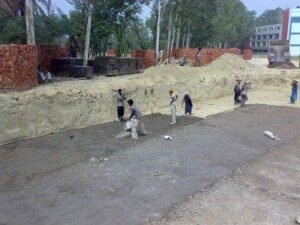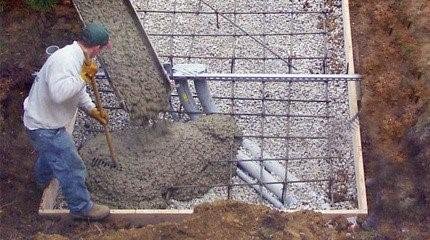
What is Plain Cement Concrete (PCC)?
What is Plain Cement Concrete (PCC)?
Plain cement concrete is a cement mixture commonly used for paving and flooring and is also known as PPC. It is one of the most important elements in a building structure. PCC is laid on the soil surface and acts as a shield for the reinforced Cement Concrete against direct contact with soil and water.

Materials used for the making of Plain Cement Concrete
Coarse Aggregate
Coarse aggregate used in construction must be a mixture of granite or similar hard broken stone, clear from foreign matter such as dirt and dust. A 20 mm stone ballast can be used which should be equal or smaller in size. A 5mm square mesh is to be used to retain any coarse material, which is graded by the standard of 42%, so it does not exceed the voids.
Fine Aggregate
A screen of 5 mm square mesh is to be used to Fine Aggregate. Ensure that natural sand consisting of pointed, hard, and angular grains will pass through the screen. Sand quality must be checked and examined for any dust, dirt, or organic matter while ensuring that sea sand shall not be used.
Cement
The Portland Pozzolana Cement (PCC)is usually used for making the PCC. The examined cement has certain specifications and encompasses the demanded ultimate strength and has compression strength and expertise.
Water
Administer the quality of water to keep it clean and free of harmful materials such as salts, acids, and alkalis that may hinder the process. A value of not less than 6 should be indicated in the pH scale for the use of clean water. The limits for solids which is permissible should be as per Clause 5.4, Page No 15, IS 456:2000
Proportioning of Plain Cement Concrete
Usually, a mix of 1:2:4 or 1:3:6 is practised. Although, it is dependent on the requirement and specification.
Volume batching or weight batching is the standard measurement technique of material.
In volume batching, coarse aggregate and sand shall be measured by measuring box of 30cmx30cmx38cm of a suitable size equivalent to one bag cement of 1/30 m3or 0.035 m3.
Sand shall be measured based on its dry volume.
Ramming, hammering, or sacking shouldn’t be done while measuring the aggregate.
Mixing of Plain Cement Concrete
There are two means to achieve a perfect mixing of Plain Cement Concrete either manually or through machines :
Hand Mixing
Hand-mixing is usually the technique of mixing Plain Cement Concrete in small small-scale work.
Use a watertight slab, a steel platform, or a clean surface for mixing the concrete.
The mixing of cement is done thoroughly by adding sand and cement. Lastly, to achieve consistency and even colour, water is added to the mixture is mixed accurately.
Machine Mixing
Hopper is used for placing the cement, fine aggregate, and dry coarse aggregate in the specified measured quantity.
A mixing drum is to be used to mix the dry materials. The process should be done for a minimum of four cycles, followed by adding the specific quantity of water steadily while the drum is in action.
To achieve the specific cement-water ratio, water for mixing should be introduced in sufficient quantity before 25% of the mixing time has passed.
A plastic mix of uniform colour is to observe the mixing process.
Note: The quantity of water to be used for each 50kg cement mix to give the desired consistency is as follows:
- Not more than 34 litres – 1:3:6 mix
- Not more than 30 litres – 1:2:4 mix
- Not more than 27 litres – 1:1 ½:3 mix
- Not more than 25 litres – 1:1:2 mix.
Laying of Plain Cement Concrete
The Plain Cement Concrete is laid in layers not more than 150mm thick. Mechanical vibrators are used to thoroughly vibrate the RCC to obtain dense concrete.
Perform hand compaction to ensure that the concrete is evenly pasted in the corners of the framework. A wooden tampering rod would help achieve uniformity and assure all the corners are completely walked.
Administer the hand compaction and make sure it is completed within the phase where the initial selling starts. Usually, this is within 30 minutes of adding water to the dry mixture.

Laying of Plain Cement Concrete in Footing Pits
Curing of Plain Cement Concrete
It should be ensured that in the case of rainy weather the freshly laid concrete should be protected by using a cover.
After about one to two hours, the concrete begins to harden. Cover the concrete with sand, gunny bags, or quick-drying materials.
The surface is laid for over 24 hours is to be cured by submerging the surface with water of about 25mm depth or covering the surface with weight absorbent materials.
A period of 14 days is the minimum time for curing to be performed.

Finished Surface of PCC
Dos and Don’ts of PCC Works
Dos
Exact size and thickness should be ensured for What is Plain Cement Concrete shuttering.
A measured quantity as per the w/c (water/ cement) ratio to administer when mixing in a bucket.
To pour concrete where the depth is more, use a chute or additional labour.
Ensure to remove any loose material which can be present on the sides of the pit. It is to ensure no other material or sand gets mixed in the concrete.
The de-watering should be carried out at a similar time during concreting if there is a high water table.
Don’t
Ensure that the PCC is not mixed with the materials on bare land.
A Plain Cement Concrete without formwork is strongly not recommended.
Ensuring that levelling and compacting are completed, only then pour concrete.
A pit height of no more than 1.5m is appropriate to pour the concrete.
To ensure a smooth surface, do not allow extra mortar on top of PCC.
Advantages of Laying Plain Cement Concrete
Expected cover to bottom support is secured, as cover blocks rest on a specific PCC.
As the formworks can be consistently, quickly, and sturdily fixed, the practical depth of RCC members is delivered which results in better dimension precision of foundation RCC member.
To avoid steel corrosion in the immediate future, reinforcement steel bars are placed on PCC to ensure no contact with the chemically active ground soil.
The placement of steel cages and productivity is enhanced.
Concrete does not blend with ground soil as PCC acts as a barrier to the soil. It bonds well to overlayed structural grade concrete.
PCC plays an important role by providing a protective base layer for the structure above it. At Samruddhi, we follow the best industry practices and guarantee you the best results. Connect with us today and let experts take care of all your construction needs.
Archives
Categories
- No categories


